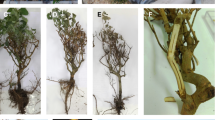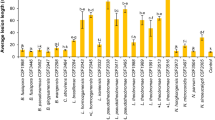Abstract
Tibouchina spp. (Melastomataceae) are native to South America, but have been planted as ornamentals in many southern hemisphere countries. The Melastomataceae are members of the Myrtales and are close relatives of the Myrtaceae, to which the genus Eucalyptus belongs. The recent discovery of several Chrysoporthe spp. on Tibouchina spp. has prompted a more detailed survey for other Eucalyptus pathogens that might occur on this tree. In this study, the discovery in Australia of Holocryphia eucalypti, a Eucalyptus pathogen, on diseased stems of Tibouchina urvilleana is reported. Characterisation of this fungus was based on morphology and comparisons of β-tubulin gene sequences. Greenhouse pathogenicity tests, including isolates of H. eucalypti from Eucalyptus spp. in Australia and South Africa, showed that the isolates of H. eucalypti from T. urvilleana were significantly more pathogenic on T. urvilleana than isolates from Eucalyptus.
Similar content being viewed by others
References
Appel DN, Stipes RJ (1986) A description of declining and blighted pin oaks in eastern Virginia. Journal of Arboriculture 12, 155–158.
Carnegie AJ (2007a) Forest health condition in New South Wales, Australia, 1996–2005. I. Fungi recorded in eucalypt plantations during forest health surveys. Australasian Plant Pathology 36, 213–224. doi: 10.1071/AP07020
Carnegie AJ (2007b) Forest health condition in New South Wales, Australia, 1996–2005. II. Fungal damage recorded in eucalypt plantations during forest health surveys and their management. Australasian Plant Pathology 36, 225–239. doi: 10.1071/AP07021
Felsenstein J (1985) Confidence intervals on phylogenetics: an approach using the bootstrap. Evolution 39, 783–791. doi: 10.2307/2408678
Glass NL, Donaldson GC (1995) Development of primer sets designed for use with the PCR to amplify conserved genes from filamentous ascomycetes. Applied and Environmental Microbiology 61, 1323–1330.
Gryzenhout M, Eisenberg BE, Coutinho TA, Wingfield BD, Wingfield MJ (2003) Pathogenicity of Cryphonectria eucalypti to Eucalyptus clones in South Africa. Forest Ecology and Management 176, 427–437. doi: 10.1016/S0378-1127(02)00309-2
Gryzenhout M, Myburg H, Hodges CS, Wingfield BD, Wingfield MJ (2006a) Microthia, Holocryphia and Ursicollum, three new genera on Eucalyptus and Coccoloba for fungi previously known as Cryphonectria. Studies in Mycology 55, 35–52.
Gryzenhout M, Rodas CA, Portales JM, Clegg P, Wingfield BD, Wingfield MJ (2006b) DNA sequence comparisons and morphological characteristics reveal novel hosts of the Eucalyptus canker pathogen Chrysoporthe cubensis and a new Chrysoporthe species from Colombia. Mycological Research 110, 833–845. doi: 10.1016/j.mycres.2006.02.010
Murray MG, Thompson WF (1980) Rapid isolation of high molecular weight plant DNA. Nucleic Acids Research 8, 4321–4325. doi: 10.1093/nar/8.19.4321
Myburg H, Gryzenhout M, Heath RN, Roux J, Wingfield BD, Wingfield MJ (2002a) Cryphonectria canker on Tibouchina spp. in South Africa. Mycological Research 106, 1299–1306. doi: 10.1017/S095375620200669X
Myburg H, Gryzenhout M, Wingfield BD, Wingfield MJ (2002b) β-tubulin and Histone H3 gene sequences distinguish Cryphonectria cubensis from South Africa, Asia and South America. Canadian Journal of Botany 80, 590–596. doi: 10.1139/b02-039
Myburg H, Gryzenhout M, Wingfield BD, Stipes RJ, Wingfield MJ (2004) Phylogenetic relationships of Cryphonectria and Endothia species, based on DNA sequence data and morphology. Mycologia 96, 990–1001.
Old KM, Murray DIL, Kile GA, Simpson J, Malafant KWJ (1986) The pathology of fungi isolated from eucalypt cankers in south-eastern Australia. Australian Forestry Research 16, 21–36.
Roane MK, Stipes RJ, Phipps PM, Miller OK Jr (1974) Endothia gyrosa, causal pathogen of pin oak blight. Mycologia 66, 1042–1047. doi: 10.2307/3758321
SAS Statistical Software (1989) ‘SAS/STAT User’s Guide. Version 6. Vol. 1 & 2.’ 4th edn. (SAS Institute Inc.: Cary, NC)
Shear CL, Stevens NE, Tiller RJ (1917) Endothia parasitica and related species. United States Department of Agriculture Bulletin 380, 1–82.
Stipes RJ, Phipps PM (1971) A species of Endothia associated with a canker disease of pin oak (Quercus palustris) in Virginia. Plant Disease Reporter 55, 467–469.
Swofford DL (2002) ‘PAUP*. Phylogenetic analysis using parsimony (*and other methods)’. Version 4. (Sinauer Associates: Sunderland, MA)
Thompson JD, Gibson TJ, Plewniak F, Jeanmougin F, Higgins DG (1997) The CLUSTAL W windows interface: flexible strategies for multiple sequence alignment aided by quality analysis tools. Nucleic Acids Research 25, 4876–4882. doi: 10.1093/nar/25.24.4876
Van der Westhuizen IP, Wingfield MJ, Kemp GHJ, Swart WJ (1993) First report of the canker pathogen Endothia gyrosa on Eucalyptus in South Africa. Plant Pathology 42, 661–663. doi: 10.1111/j.1365–3059.1993.tb01548.x
Venter M, Wingfield MJ, Coutinho TA, Wingfield BD (2001) Molecular characterisation of Endothia gyrosa isolates from Eucalyptus in South Africa and Australia. Plant Pathology 50, 211–217. doi: 10.1046/j.1365–3059.2001.00556.x
Venter M, Myburg H, Wingfield BD, Coutinho TA, Wingfield MJ (2002) A new species of Cryphonectria from South Africa and Australia, pathogenic to Eucalyptus. Sydowia 54, 98–117.
Walker TJ, Old KM, Murray DIL (1985) Endothia gyrosa on Eucalyptus in Australia with notes on some other species of Endothia and Cryphonectria. Mycotaxon 23, 353–370.
Wardlaw TJ (1999) Endothia gyrosa associated with severe stem cankers on plantation grown Eucalyptus nitens in Tasmania, Australia. European Journal of Forest Pathology 29, 199–208. doi: 10.1046/j.1439-0329.1999.00143.x
Yuan ZQ, Mohammed C (1997) Investigation of fungi associated with stem cankers of eucalypts in Tasmania, Australia. Australasian Plant Pathology 26, 78–84. doi: 10.1071/AP97013
Yuan ZQ, Mohammed C (1999) Pathogenicity of fungi associated with stem cankers to Eucalyptus in Tasmania, Australia. Plant Disease 83, 1063–1069. doi: 10.1094/PDIS.1999.83.11.1063
Yuan ZQ, Mohammed C (2000) The pathogenicity of isolates of Endothia gyrosa to Eucalyptus nitens and E. globulus. Australasian Plant Pathology 29, 29–30. doi: 10.1071/AP00005
Author information
Authors and Affiliations
Corresponding author
Rights and permissions
About this article
Cite this article
Heath, R.N., Roux, J., Gryzenhout, M. et al. Holocryphia eucalypti on Tibouchina urvilleana in Australia. Australasian Plant Pathology 36, 560–564 (2007). https://doi.org/10.1071/AP07059
Received:
Accepted:
Issue Date:
DOI: https://doi.org/10.1071/AP07059




